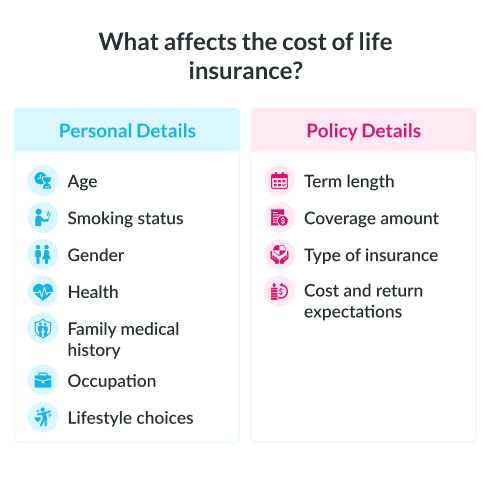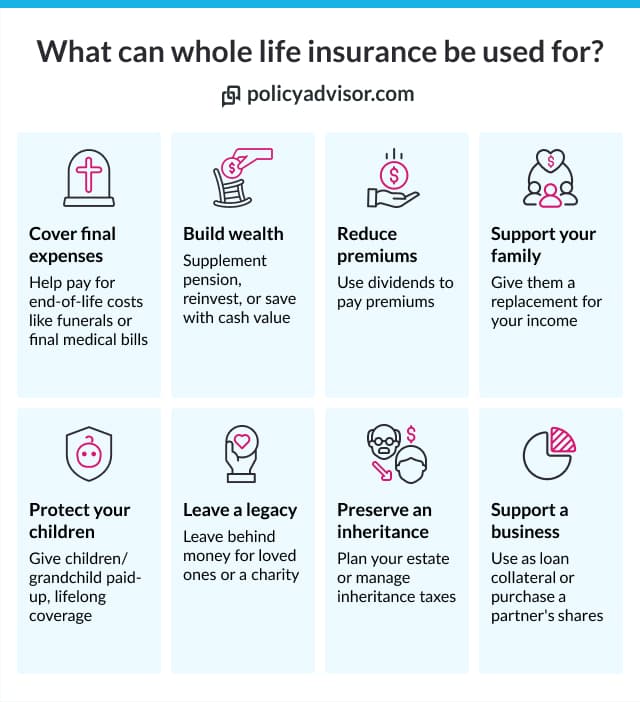How much does whole life insurance cost in Canada (2024)?
Whole life insurance can cost anywhere from $45-$100 per month, depending on your personal profile and the type of coverage you need. Whole life insurance rates tend to be more expensive than term life insurance rates because the payout is guaranteed at the end of your life and there is a savings component to the policy. Whole life insurance is worth the price if you want your life insurance to offer investment growth opportunities, stable premiums, and lifetime coverage.
- What is whole life insurance?
- Participating whole life insurance cost vs. non-participating whole life insurance
- How much is whole life insurance?
- Whole life insurance rates by age
- Whole life insurance calculator
- What affects the cost of whole life insurance?
- Is whole life insurance worth it?
- Whole life insurance quotes
You can expect to pay anywhere from $45-100 per month for whole life insurance. But nailing down the exact cost of whole life life insurance can be tricky. First off, “whole life” is often used as a catch-all term for all types of permanent life insurance policies, when it’s actually just one type of permanent insurance. Secondly, whole life insurance has a lot of policy options that affect the price.
In this article, we’ll break down what whole life insurance is and all the factors that influence the monthly premium, so you can find out if whole life insurance is worth it.
What is whole life insurance?
Whole life insurance protects you for your entire life, paying out a tax-free lump sum of cash to your estate or your beneficiaries when you pass away. The policy length is not a particular term, it lasts for as long as you live. As long as you pay your life insurance premiums, your policy never expires — it’s as simple as that.
Whole life policies come with a living benefit called a cash value component. As you pay your premiums over your lifetime, part of that money is invested and generates a tax-deferred cash value that grows over time.
Whole life insurance is just one type of permanent coverage. There are also other types of permanent life insurance like universal life insurance and term to age 100 insurance.
Participating whole life insurance price vs. non-participating whole life insurance
Beyond the perk of cash value, some whole life insurance policies, called “participating policies,” offer additional investment perks. Whole-life policies that just have the cash value and no additional investment perks are known as “non-participating.” Whether your policy is participating or not has a large influence on the cost of life insurance.
- Participating Whole Life Insurance
In addition to accessing the cash value, the policyholder also receives dividends – typically annually. They “participate” in the insurance company’s investments because their premiums are used for the investments. Because of this additional growth generation component, participating policies are more expensive than non-participating policies. - Non-Participating Whole Life Insurance
The policyholder does not receive dividends and thus premiums are guaranteed, level, and generally lower.
How you pay your premiums will also have an effect on the cost of your whole life insurance.
- Life Pay Whole Life Insurance
You pay the premiums for your entire life and receive coverage for life. - Limited Pay Whole Life Insurance
You only pay premiums for a set amount of time, not your entire life, but still get coverage for your whole life. It’s like an accelerated payment plan. Because of this limited pay period, the premiums are typically higher.
How much does whole life insurance cost?
For non-participating whole life insurance, you can expect to pay around $65/month for $100,000 in coverage, if you are in your 30s and in good health. The average cost for participating life insurance is about $75 for the same amount of coverage.
As we hinted above, whole life insurance tends to be more expensive than term life Insurance rates because the payout is guaranteed at the end of your life and there is a savings component to the policy.
Additionally, as with other types of insurance, whole life coverage costs more as you age. The later you buy, the less time your insurance companies has to collect enough premium to pay for the cost of insurance before they have to make a guaranteed payment. With that said, the chart below is a sample of average life insurance rates by age for whole life insurance.
Whole life insurance quotes in Canada
| Age | $100K coverage - non participating | $100K coverage - participating |
|---|---|---|
| 20 | $47/month | $54/month |
| 30 | $65/month | $75/month |
| 40 | $92/month | $110/month |
| 50 | $149/month | $164/month |
| 60 | $245/month | $263/month |
| 70 | $462/month | $444/month |
*Quotes based on $100k in coverage for a non-smoker in regular health on a life-pay plan. Quotes based on average prices from leading insurance companies in Canada.
Whole life insurance calculator Canada
Wondering how much insurance you might need? The above numbers give you some idea what Whole Life Insurance might cost, but check out our life insurance calculator to get a full, holistic view of what it takes to solidify your financial security. There you can start comparing quotes and insurance plans for whole life coverage.

What affects the cost of whole life insurance?
The cost of insurance in Canada can change depending on your personal details and also your policy’s details.
Personal Factors
- Age and Birthday
Life insurance costs increase with age due to higher statistical risks. - Gender
Women generally have lower life insurance costs due to longer life expectancy. - Smoking Status
Smoking significantly raises life insurance premiums. Products like cigarettes, e-cigarettes, and marijuana usage impact rates. Quitting smoking for 12 months may lead to cost savings. - Health History
Healthy individuals with good BMI, no pre-existing health conditions, and favorable medical exam results receive lower premiums. Refusal of a medical exam or poor health leads to higher costs. - Family Medical History
Hereditary conditions in family history impact life insurance rates. - Lifestyle
Engaging in risky activities, criminal history, or having a poor driving record increases costs. - Occupation
Dangerous occupations like firefighting or military service may lead to higher rates or coverage denial. - Foreign Travel
Regular travel to high-risk nations may elevate life insurance costs. - Risk Classification
Underwriters categorize individuals based on risk factors, affecting the premium.
Policy Factors
- Length and Type of Policy
Longer coverage duration leads to higher costs. Whole life insurance is more expensive than term life insurance products. - Coverage Amount
Higher death benefit requests result in more expensive policies. - Policy Options and Riders
Additional features like convertibility, critical illness riders, and more increase costs. Adding optional life insurance riders enhances the policy but comes at a higher price.
Because there are so many factors that affect policy premiums, the best way to know how much your whole life will cost is to get your own quote from PolicyAdvisor.com. Use our online quoting tool to get an instant quote in seconds.
Is whole life insurance worth it?
Whether or not you need whole life insurance depends entirely on both your personal choice and circumstances. It can provide a financial safety net while you’re alive by utilizing the cash value as well as provide security for your family after you pass away.
Key benefits of whole life insurance include:
- Lifelong coverage– Your policy will never expire once premiums are paid
- Cash value growth– Premium payments are reinvested and grow cash value that you can access during your lifetime
- Dividends (participating policies only) – Annual dividend payments can be used to reinvest, withdraw, buy more insurance, or more
- No market volatility– The investment component is managed by the insurance company and it does not fluctuate with the market
- Guaranteed death benefit– Life insurance will pay out when you pass away no matter what
- Death benefit growth– Your death benefit or coverage amount can grow over time with cash value or dividends
- Level premiums– The cost of your policy will remain consistent as long as your policy
- Limited pay options– Your policy can be paid off in a short time frame so you don’t have to worry about it later
The main disadvantages of whole life policies are:
- Premiums can be expensive– Whole life policies can cost more than other types of life insurance, like term
- Not as flexible as term life insurance– You cannot select coverage for just a set period; it can only last forever
- Investment potential may not be as large as with other investments– Growth from a portfolio managed by the life insurance company will be moderate
Whole life insurance can be a great product to meet specific needs, so it can be worth the price. The best way to determine if whole life insurance is best for your financial goals is to speak with an expert advisor.
Get a whole life insurance quote
If you need answers about whole life insurance right away, don’t hesitate to schedule a call with one of our licensed insurance advisors. They can answer any of your questions about whole life insurance, help you identify any gaps or shortfalls in your current coverage, and start you on the path to coverage if you so wish. In the meantime, calculate your life insurance coverage needs or get life insurance quotes online.


 1-888-601-9980
1-888-601-9980


